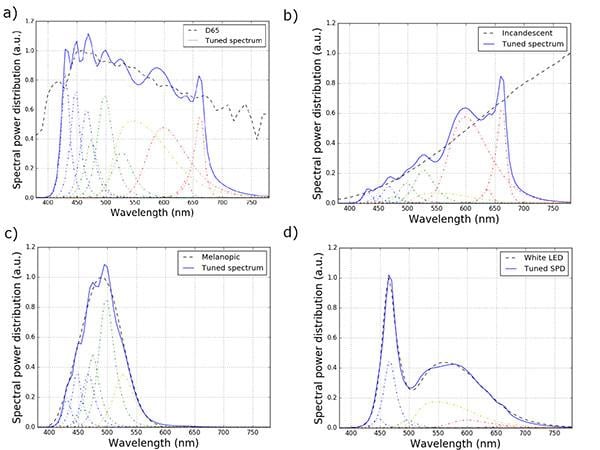
Computational Methods Enable Solid-State Lighting to Self-adjust
BARCELONA, Spain, April 2, 2019 — Researchers from the Catalonia Institute for Energy Research (IREC) and Ledmotive Technologies have developed a two-step approach to precisely and efficiently generate spectral power distributions (SPDs) using multichannel LED engines. This approach could be used to help resolve temperature and color shifts and flux variations in LED emissions.
The team addressed two challenges: how to keep temperature changes and age-based deterioration from affecting a light emission’s strength, consistency, and color; and how to provide a reliable, internal, self-monitoring method that is able to keep an emitted spectrum constant and stable over time.
First, the researchers studied different algorithms that could be used to find the channel weights that would best match a target SPD. They found that a simulated annealing algorithm delivered good results with regard to spectral fidelity while requiring extremely low computation times.
Then, the researchers implemented a closed-loop control system to monitor and correct spectral deviations in the emitted light and to compensate for spectral shifts due to temperature changes or depreciation of the LEDs.

These four examples show (a) the best fit (blue solid line) to daylight D65, (b) an incandescent spectrum, (c) the melanopic, and (d) a white LED spectrum (Ph-LED YAG) (dashed black lines) made by optimizing the weights of the 10 different channels of the LED light engine (colored dash-dot lines). In all cases, the spectra were normalized and are shown in arbitrary units. Courtesy of Aleix Llenas, Catalonia Institute for Energy Research, and Josep Carreras, Ledmotive Technologies, Barcelona, Spain.
These two steps can be used independently, but the researchers said that only a combination of both steps will offer both fast computational times and high spectral accuracy and precision. Some solid-state lighting (SSL) applications — medicine, agriculture, imaging, and museum lighting, among others — require highly precise light spectra that will not produce optical power variations or shifts in color over time. The team’s methods set a general framework for multichannel SSL systems and could be applied to different systems and lighting technologies.
According to Optical Engineering associate editor Daniel A. LeMaster, the research showcases significant advances in terms of lighting technologies: “This method to monitor and quickly compensate for the colorimetric issues that arise from junction heating and LED aging will be of great utility in the global LED lighting market.”
The research was published in Optical Engineering, a publication of SPIE (https://doi.org/10.1117/1.OE.58.3.035105).
/Buyers_Guide/LEDMOTIVE/c31234